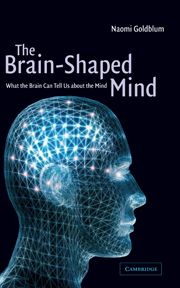Book contents
- Frontmatter
- Contents
- Preface
- Figure permissions and acknowledgments
- 1 Introduction
- 2 What the brain cannot tell us about the mind
- 3 How neurons form networks
- 4 Theories and models of how the mind functions
- 5 What are connectionist networks?
- 6 How our networks learn
- 7 Connecting the networks: how different things are related
- 8 Evidence for connectionist models
- 9 Two different types of memory
- 10 Coping with disaster
- 11 Practical implications
- 12 Criticism of connectionist theory
- Annotated references and suggested readings
- Index
5 - What are connectionist networks?
Published online by Cambridge University Press: 02 December 2009
- Frontmatter
- Contents
- Preface
- Figure permissions and acknowledgments
- 1 Introduction
- 2 What the brain cannot tell us about the mind
- 3 How neurons form networks
- 4 Theories and models of how the mind functions
- 5 What are connectionist networks?
- 6 How our networks learn
- 7 Connecting the networks: how different things are related
- 8 Evidence for connectionist models
- 9 Two different types of memory
- 10 Coping with disaster
- 11 Practical implications
- 12 Criticism of connectionist theory
- Annotated references and suggested readings
- Index
Summary
We have seen that there are many problems with semantic networks. The ones we have discussed involve the networks' inability to do many of the things they were designed to do. But there is another, more important reason why semantic networks are inadequate for explaining how the mind works. This is the fact that the human mind has to do much more than just organize information. It also has to perceive new information coming in through the senses and figure out how it fits in with the information already there, and then it has to decide what to do on the basis of all this information. This involves perception and action, and semantic network models were never designed in the first place to be able to handle these human capabilities.
Yet if we look at the brain we see that the areas which process information coming in from our senses, as well as the areas where actions are planned, do not look very different from the areas where various sorts of information are associated or the areas where thinking and reasoning take place. But our basic assumption has been that the way the mind works – as opposed to the actual information it contains – is closely related to the structure of the brain. We therefore ought to look for a theory about the mind's operation that works for perception and action as well as for associations and reasoning.
Transforming semantic networks into connectionist networks
Since we began with semantic networks, let's see if there's anything we can do with them to make them a more plausible candidate for the organizing force of the mind that is based on the way the brain is structured.
- Type
- Chapter
- Information
- The Brain-Shaped MindWhat the Brain Can Tell Us About the Mind, pp. 40 - 53Publisher: Cambridge University PressPrint publication year: 2001



